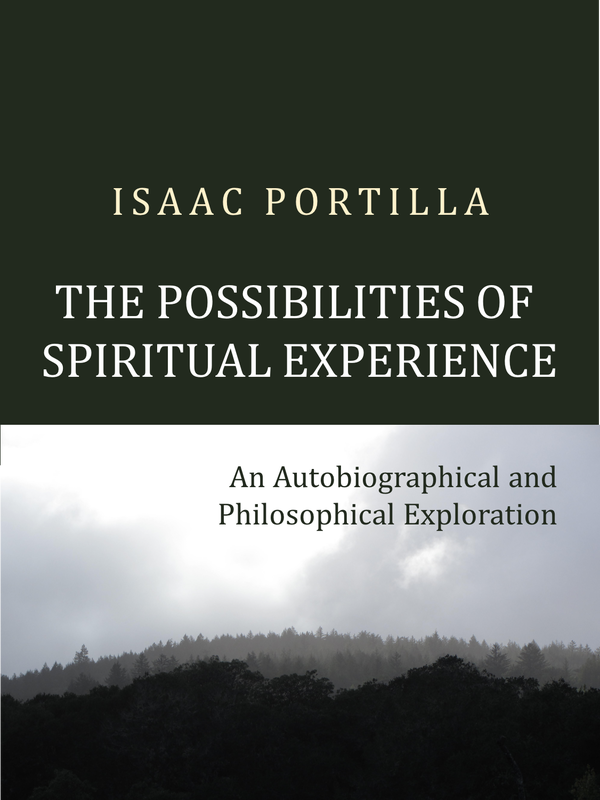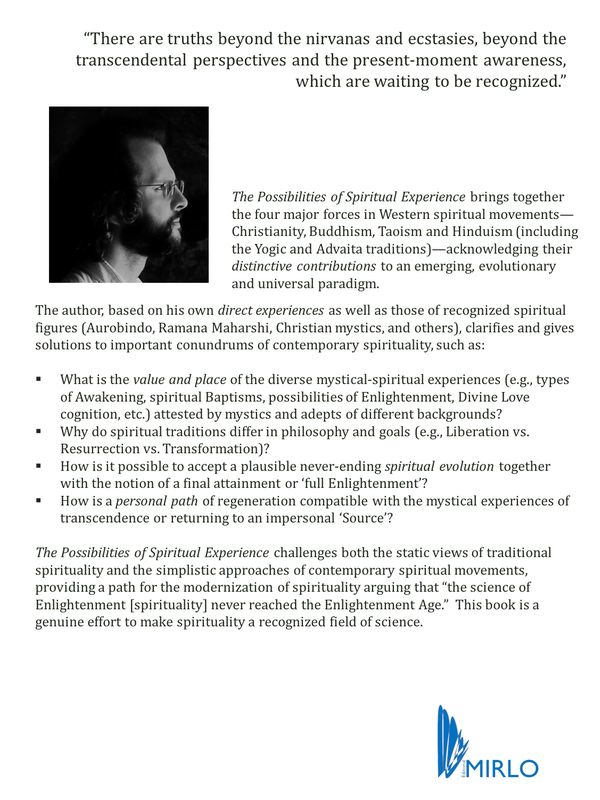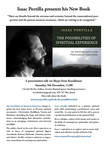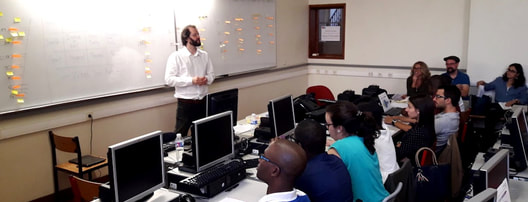|
The Possibilities of Spiritual Experience: An Autobiographical and Philosophical Exploration
“There are truths beyond the nirvanas and ecstasies, beyond the transcendental perspectives and the present-moment awareness, which are waiting to be recognized.”
The Possibilities of Spiritual Experience brings together the four major forces in Western spiritual movements—Christianity, Buddhism, Taoism and Hinduism (including the Yogic and Advaita traditions)—acknowledging their distinctive contributions to an emerging, evolutionary and universal paradigm.
The author, based on his own direct experiences as well as those of recognized spiritual figures (Aurobindo, Ramana Maharshi, Christian mystics, and others), clarifies and gives solutions to important conundrums of contemporary spirituality, such as:
Questions and AnswersThe following questions and answers section is based on correspondence and feedback. The questions and answers have been extended and edited to be more useful for a general audience. You can send your questions and comments using the contact form. Some of the received questions or comments will be included in this section in a generic form.
Does the Personal Spirit of your Three Pillars Model have anything to do with the concept of Atman in the Eastern traditions?
Atman, in Indian Dharma, is considered either the ‘I’-sense (the sense of existence) or the Universal Spirit (Brahman), sometimes both (Atman is self and Absolute). Effect-oriented schools or teachers emphasize the identity between Atman and Brahman, making them almost indistinguishable so to speed up Self Realization—their cherished goal. On the other hand, scientifically-oriented schools or teachers, concerned with the philosophical accuracy of their statements, make a distinction between them. The Three Pillars Model, emerging through a scientifically-oriented enquiry process, clearly differentiates the ‘I’-sense (Atman) and the Universal Spirit (Brahman or Super-Atman), as two distinguishable aspects of being. The ‘I’-sense (Atman) pertains to the category of the subtle being; the Universal Spirit (Super-Atman)—to the spirit being. The Personal Spirit you mention, in the Model, refers to the inherent Christ-nature (in the Christian tradition) and the so-called Individual Divine (in Aurobindo’s Integral Yoga). It is different from the ‘I’-sense (Atman) or soul, and from the Universal Spirit (Brahman). Only, if we take a very ancient meaning of Atman, when the sense of self was felt in closer association with the vital breath (Prana-Atman), there would be a higher proximity with the Personal Spirit, because the notion of Prana-Atman would fall within the Second (or Logos) Pillar of the Model (let us remember that the Model’s rules for the ‘I’-sense allow its horizontal mobility within the subtle being, thus, the contextual transfer of a vital or pranic Atman from the First Pillar to the Second would be possible). Nevertheless, such Pillar transfer would not imply the identity of Atman with the Personal Spirit: Prana-Atman would be accompanying the aspect of the subtle being corresponding to the Second Pillar—the vital body—not the Personal Spirit, which belongs to the spirit being. The Three Pillars Model makes a clear distinction between the ‘I’-sense (Atman) and the three aspects of Spirit—the Universal Spirit (Brahman or Super-Atman), the Personal Spirit (Christ-nature) and the Spirit Force. In this way, the Model reflects the reality of many possibilities of mystical interaction, since the ‘I’-sense can be experienced not only by itself (as the sense of existence), but also in combination with each one of three aspects of Spirit: it may be experienced in a state of latency, as if dissolved, upon the contemplation of the Universal Spirit (when Atman and Super-Atman seem to be co-essential); it can be seen as reflector of Light-power through the manifestation of the Personal Spirit (Christ-nature); it can be known in communion with the Spirit Force as Divine Love (Agape). In sum, there is a difference between the ‘I’-sense (Atman) and any of the three aspects of Spirit, and there are experiential differences expressed through conscious relations between them. (Further reading: ‘Third Advantage of the Model: Equal Acknowledgement of All Aspects of Being’ p. 181-186; ‘Chart 1. The Nine Aspects of Being’ p.194-; The Possibilities of Spiritual Experience: An Autobiographical and Philosophical Exploration.) In relation to the Spirit Force as Primordial Power and Divine Energy: Does the term ‘Primordial’ refer to the same reality as the ‘Unmanifest’ or ‘Formless’? Does it have any connection with the concept of the ‘Tao’?
The adjective ‘Primordial’ is used to emphasize the Spirit Force as an aspect of the Divine not created by the Universal Spirit, and thus not subordinated to the Absolute or fatherly Source. This is the reason why, in the Christian tradition, the Holy Spirit-Force is often referred to as ‘Uncreated Energy’. Indeed, it is not the Brahmanic Truth which wills and creates a power of its own, but the Spirit Force is the Will—the Divine itself. Moreover, although the Spirit Force does not have a defined form, it is not formless as the Absolute is: the Spirit Force “draws” lines of Will, which are experienced as “ups and downs” within our embodied existence, so there are directions or paths in its conscious manifestation. Therefore, the Spirit Force is neither formed nor formless—it is the Divine Will which manifests conscious evolutionary existence. The words ‘Unmanifest’ and ‘Formless’ you mention generally refer to the Absolute or Universal Spirit (or to attributes of it), which is the first aspect of Spirit (i.e., the first aspect of the Trinity), not the third—the Spirit Force. The Absolute reveals itself in our awareness as all-pervading Consciousness, the substratum of our existence, later, as Clear Emptiness in all (an evolutionary insight introduced by the Buddha), and so forth. The attribute of formlessness is thus given due to its apparent omnipresence, a characteristic inferred from mystical perception when the awareness of the Absolute is added to our normal perception of reality and its ‘objects’. Quite differently, the notion of the Absolute as unmanifest Reality comes, not from mystical perception, but as a contrast with our ordinary experience of reality, which we consider “manifested” to our senses. However, once the Absolute is perceived together with the sensorial world, there arise philosophical questions regarding whether the Absolute is truly “unmanifest” Reality, and whether it is active in sensorial manifestation. Finally, the concept of the Tao is more abstract and difficult to address, because it employs not only the Absolute, but certain dynamics of movement in relation to it. The Taoist tradition has been very emphatic in developing vital harmony in both motion and stillness, and to cultivate the fine-tuning of our being with the rhythms of existence. Therefore, the Taoist conception of the Absolute is less static than the Advaitic, Yogic or Buddhist, as the notion of the Tao was developed always in relation with the way we are in harmony with life. Some could argue that there might be a connection between the existential movements within the Tao and the power dynamics of the Spirit Force, but I do not think there is enough base for such connection. On the contrary, an assertion of that kind can lead to clear misconceptions. In my experience, the Spirit Force manifests its transformative Power within a context of stillness as container, while harmony with the Tao is a very different experience (to move without movement, Wei Wu Wei), complementary nevertheless. The Three Pillars Model reflects this differentiation: Harmony is a Second Pillar experience; Divine Bliss—a Third Pillar one, associated with the Primordial Power or Spirit Force. (For further reading: ‘Chart 2. Basic Correspondences’ p.210-, The Possibilities of Spiritual Experience: An Autobiographical and Philosophical Exploration.) I practice Hatha Yoga, chant Mantras and do Buddhist contemplation. How can my spiritual practice benefit from the Three Pillars Model?
The Three Pillars Model is a framework which allows you to understand the possibilities of spiritual experience, and the relations between experience, philosophy and practice throughout your path. Although its particular Practices and Programs were not included in this volume, the Three Pillars Model, as a referential framework, can already help you to design and explore your current spiritual program, especially if you are able to identify which aspects of being are employed in each practice, and what is the goal of such practice within the Model. Considering that the experiences object of my research (mystical-spiritual experiences of divine nature) happen within three major spiritual processes (Realization, Regeneration, Development) corresponding to each Pillar, you could reflect on your current program in the following manner: Hatha Yoga employs the physical body and the local attention. Hatha Yoga, in conjunction with breath exercises and Chakra meditation, was designed to facilitate the ascent of the Spirit Force, or at least to prepare the body-mind for such process. Using the Model’s terminology, Hatha Yoga is, therefore, a Third Pillar practice, useful within the Awakening phase of Development (the ascending phase). A first observation would be that, if you wish to facilitate the descent of the Spirit Force, that is, of Divine Love (Agape or Overmind), then you will need other practices for it, akin to the Regenerative Exercises I developed for this purpose. Some individuals and adepts may be able to combine both ascending and descending practices. Regarding Mantra practice, there are various types of Mantra, with different purposes, but, in general, since sound (vibration) opens spaces and activates energies within the evolutionary body, this practice would be, again, a Third Pillar practice. Indeed, most practices coming from the Yogic tradition are, naturally, Third Pillar oriented (they focus on the opening of the physical body and the evolutionary body, and Development through the Spirit Force). On the other hand, the last practice of your program, Buddhist contemplation, employs the local attention directed upon unfocussed awareness. It is, then, a First Pillar practice, because Buddhist contemplation and Buddhist discriminating enquiry are designed to produce insight into the Universal Spirit (the Buddhic Mind), through various stages of absorption. Therefore, in your current program (Hatha Yoga, Mantra, Buddhist contemplation) there are aspects of the First and Third Pillars, but the Second Pillar is absent. Keeping this observation in mind, if you feel there is a call in your being to experience a path which includes an emphasis on Harmony (Second Pillar’s fundamental experience), you may consider adding practices that work with emotions, and to focus on patience and forgiveness; also, certain forms of purification, and practices of energetic harmonization and grounding, which employ the vital body and the vital breath, would be useful (these practices are mostly found in the Taoist and Christian traditions). The inclusion of Second Pillar practices is especially important if you feel you do not have enough grounding, and your spiritual path is not unfolding in a deeply experiential or balanced manner (this remark is based on my experience with Westerners engaged in Eastern practices which focus on transcendental insight and energetic ascent). Thus, the Three Pillars Model can help you to identify possible deficiencies and future developments of your practice. Moreover, since Western practitioners seem to be out of touch with the original goals and potential effects of each practice they embrace, the Three Pillars Model can help to recover the aspiration toward true spiritual aims, and a more mystical and transformative orientation of the practice. (Further reading: bottom-page comment on consequences of ‘Pillar-tilting’, p. 142-143; ‘Chart 3. Exploratory Correspondences’ p. 220-, The Possibilities of Spiritual Experience: An Autobiographical and Philosophical Exploration.) © 2018 Isaac Portilla
| |||||||||








